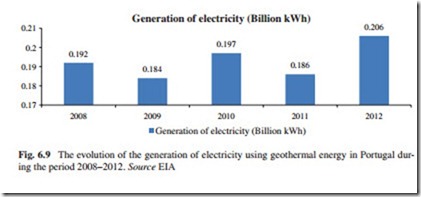Portugal
According to Geothermal Finance and Awareness in European Region, the geology of Portugal determines different conditions for the exploitation of its geothermal energy sources. On the mainland, where crystalline rock outcrops over 60 % of the area, thermal waters are related to active faulting. For this rea- son, the limited geothermal resources located in mainland Portugal have been developed so far for direct use. A dozen of feasibility studies already carried out throughout the country demonstrates adequate conditions for the operation of geothermal power plants in certain part of it. Based on these studies, the presence of high-temperature geothermal resources is restricted to the volcanic islands of the Azores, more precisely on the Sao Miguel Island, which are associated with the triple junction of the North American, Eurasian, and African plate (Cabeças et al. 2010).
The Sao Miguel island has five geothermal power plants for the generation of electricity, achieving a total capacity of 16 MWe, one on the Pico Vermelho site (3 MWe) and four binary cycle power plants on the Ribeira Grande site (13 MWe). The expansion of the installed capacity at the Ribeira Grande field and the development of other projects in new areas where exploration has been carried out recently are expected to increase the penetration of geothermal in the country energy mix up to 75 % by 2018.8 New investment projects at the Ribeira Grande geothermal field on the island of São Miguel, implemented by SOGEO (Sociedade Geotérmica dos Açores, S.A.), have more than doubled the installed generation capacity in the Azores to a total of 23 MW net, with the contribution of the new Pico Vermelho plant (10 MW net), which went into production in November 2006. Thus, power production from geothermal resources in the Azores presently meets 39 % of the needs of São Miguel, and over 20 % of the total demand of the archi- pelago. On Terceira Island, where the installation of a 12 MW net plant is planned, deep exploratory drilling conducted in the Pico Alto field has found a maximum temperature of 312 °C. Approximately €60 million were invested in drilling of new wells, generation equipment, and exploratory activities in the Azores (Cabeças et al. 2010).
A new 10-MW geothermal power plant has been built in order to replace the old Pico Vermelho power plant. A high-temperature geothermal field has also been identified on Terceira island. A drilling program has been set up with the view of installing 12 MWe to supply 50 % of the island’s needs (Antics and Scanner 2007).
In the sedimentary basins, particularly in the Lisbon area where important heat consumers are located, Lower Cretaceous reservoirs with temperatures up to 50 °C are adequate for small multi-purpose geothermal operations, but technical difficulties resulted in the stoppage of the only two existing operations. The already stud- ied potential for developing geothermal heat pumps over proven aquifers is high all over the country.
In the scope of the Portugal ambitious plan related to the increase in the use of geothermal energy source for the generation of electricity, it is expected to be developed a total of 60 MW in the following manner:
• Development of the Pico Alto project with the installation of 12-MW power plant;
• Expansion of the generation capacity installed at the Ribeira Grande field;
• Development of other projects in promising areas of São Miguel and Faial.
The total investment is expected to be approximately €200 million. Unfortunately, within the next years, the electricity demand of the other smaller islands will be still insufficient to support the development of economically viable geothermal generation projects. Given the increasing demand and (economic) interest regarding the Azores
thermal resources and potential touristic products in that area, besides the ongoing tasks regarding the Bath and SPA facilities, the INOVA Institute (with the support of SOGEO S.A.) intents to carry out several studies on the use of effluents of the Pico Vermelho power plant (including its silica thermal muds) for recreational and cosmetic purposes. In the mainland expected geothermal significant activity is not expected to be carried out in the coming years, except regarding progress in geothermal heat pump technology and exploration for EGS operations (Cabeças et al. 2010).
Generation of Electricity Using Geothermal Energy
The evolution of the generation of electricity using geothermal energy in Portugal during the period 2008–2012 is shown in Fig. 6.9.
According to Fig. 6.9, the generation of electricity in Portugal using geothermal energy source increased 7.3 %. It is expected that the generation of electricity in Portugal using this type of energy source will continue increasing at a moderate rate during the coming years.
